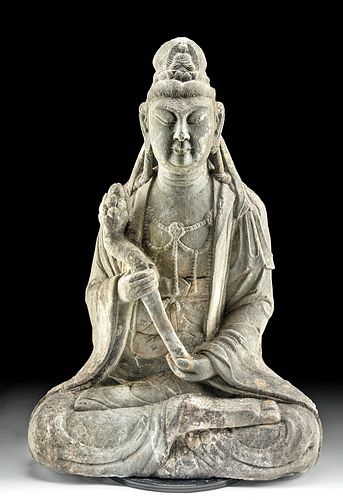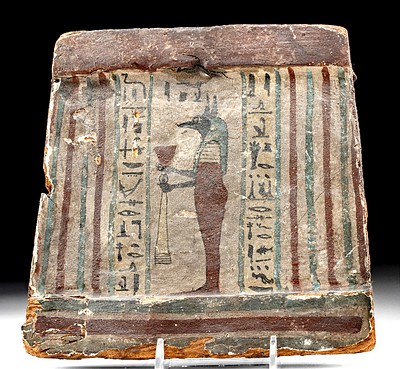Chinese Ming Stone Statue of Guanyin w/ Lotus Flower
Lot 65c
About Seller
Artemis Fine Arts
686 S Taylor Ave, Ste 106
Louisville, CO 80027
United States
Selling antiquities, ancient and ethnographic art online since 1993, Artemis Gallery specializes in Classical Antiquities (Egyptian, Greek, Roman, Near Eastern), Asian, Pre-Columbian, African / Tribal / Oceanographic art. Our extensive inventory includes pottery, stone, metal, wood, glass and textil...Read more
Categories
Estimate:
$32,000 - $48,000
Absentee vs Live bid
Two ways to bid:
- Leave a max absentee bid and the platform will bid on your behalf up to your maximum bid during the live auction.
- Bid live during the auction and your bids will be submitted real-time to the auctioneer.
Bid Increments
| Price | Bid Increment |
|---|---|
| $0 | $25 |
| $300 | $50 |
| $1,000 | $100 |
| $2,000 | $250 |
| $5,000 | $500 |
| $10,000 | $1,000 |
| $20,000 | $2,500 |
| $50,000 | $5,000 |
| $100,000 | $10,000 |
| $200,000 | $20,000 |
About Auction
By Artemis Fine Arts
Aug 26, 2021
Set Reminder
2021-08-26 10:00:00
2021-08-26 10:00:00
America/New_York
Bidsquare
Bidsquare : Fine Antiquities | Asian | Ethnographic Art
https://www.bidsquare.com/auctions/artemis-gallery/fine-antiquities-asian-ethnographic-art-7366
Features classical antiquities, ancient and ethnographic art from cultures encompassing the globe. Egyptian, Greek, Roman, Etruscan, Near Eastern, Asian, Pre-Columbian, Native American, African / Tribal, Oceanic, Spanish Colonial, Russian, Fine / Visual Arts, so much more! Artemis Fine Arts info@artemisfinearts.com
Features classical antiquities, ancient and ethnographic art from cultures encompassing the globe. Egyptian, Greek, Roman, Etruscan, Near Eastern, Asian, Pre-Columbian, Native American, African / Tribal, Oceanic, Spanish Colonial, Russian, Fine / Visual Arts, so much more! Artemis Fine Arts info@artemisfinearts.com
- Lot Description
East Asia, China, Ming Dynasty, ca. 1368 to 1644 CE. A gorgeous carved-stone statue of a Bodhisattva (also Guanyin, Guan Yin, Kuanyin in Chinese), the goddess of kindness, compassion, and mercy. Dressed in traditional garb, the elegant female is draped in a long robe that cascades down her figure in vertical pleats over a plain tunic and tied belt, while her chest is adorned with a double-strand, rope-patterned necklace boasting three lovely volutes and several plunging tassels. Her tranquil visage exhibits plump, bowed lips fixed in a gentle smile, a naturalistic nose with a low nasal bridge, and down-turned, slanted eyes under a sweeping brow. Skillfully carved with each strand of hair carefully delineated, an elaborate coiffure tops her head featuring two tightly-coiled ringlets that fall behind her ears and a bulbous top bun. A lovely ribbon with an ovoid pendant of Buddha wraps around her bun and ties in the back in a pair of bows with lengthy tails that drop over her sloped shoulders. Size: 22.5" W x 33.5" H (57.2 cm x 85.1 cm)
Her earlobes are elongated, according to tradition so that Guanyin can hear and respond to the suffering of all beings. Seated with her legs crossed in half lotus position, she holds a lotus flower with both hands. Note the artist's careful attention to detail demonstrated in the wrinkling flesh of her neck. Guanyin (Avalokiteshvara), "The Lord Who Gazes Down At The World", is a bodhisattva portrayed as both male and female who embodies the compassion of all Buddhas.
Bodhisattvas are among the most compassionate beings in the universe, devoting themselves to saving the suffering and helping others achieve enlightenment and Buddhahood. Traditionally depicted as less austere than Buddhas with graceful postures and elegant garments, a nod to the riches of the Northwestern Chinese Silk Road, this piece is no exception. Bodhisattvas or Guanyin are associated with compassion and mercy - their long ears significant, because they rescue all human beings by hearing their cries for help and the sounds of suffering.
Provenance: private Hawaii, USA collection; ex-M. Kobiashi collection, Hawaii, USA, 1960 to 2000
All items legal to buy/sell under U.S. Statute covering cultural patrimony Code 2600, CHAPTER 14, and are guaranteed to be as described or your money back.
A Certificate of Authenticity will accompany all winning bids.
PLEASE NOTE: Due to recent increases of shipments being seized by Australian & German customs (even for items with pre-UNESCO provenance), we will no longer ship most antiquities and ancient Chinese art to Australia & Germany. For categories of items that are acceptable to ship to Australia or Germany, please contact us directly or work with your local customs brokerage firm.
Display stands not described as included/custom in the item description are for photography purposes only and will not be included with the item upon shipping.
#161539Expected surface wear with light softening of detail, nicks/chips, and abrasions commensurate with age. Otherwise, excellent with lovely mineral deposits throughout.Condition
- Shipping Info
-
All shipping is handled in-house for your convenience. Your invoice from Artemis Gallery will include shipping calculation instructions. If in doubt, please inquire BEFORE bidding for estimated shipping costs for individual items.
-
- Buyer's Premium



 EUR
EUR CAD
CAD AUD
AUD GBP
GBP MXN
MXN HKD
HKD CNY
CNY MYR
MYR SEK
SEK SGD
SGD CHF
CHF THB
THB














